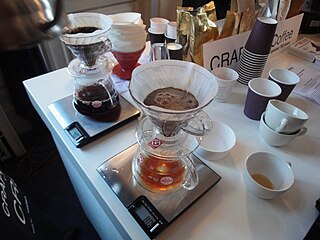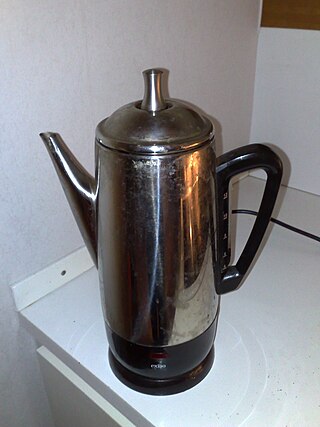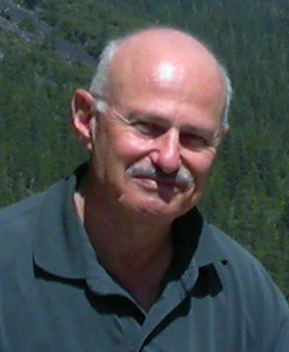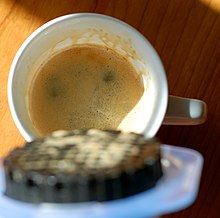
Espresso is a coffee-brewing method in which a small amount of nearly boiling water is forced under pressure through finely ground coffee beans.

A barista is a person, usually a coffeehouse employee, who prepares and serves espresso-based coffee drinks and other beverages.

A French press, also known as a cafetière, cafetière à piston, caffettiera a stantuffo, press pot, coffee press, or coffee plunger, is a coffee brewing device, although it can also be used for other tasks. The earliest known device was patented in 1852 in France by Jacques-Victor Delforge and Henri-Otto Mayer.

Drip coffee is made by pouring hot water onto ground coffee beans, allowing it to brew. There are several methods for doing this, including using a filter. Terms used for the resulting coffee often reflect the method used, such as drip-brewed coffee, or, somewhat inaccurately, filtered coffee in general. Manually brewed drip coffee is typically referred to as pour-over coffee. Water seeps through the ground coffee, absorbing its constituent chemical compounds, and then passes through a filter. The used coffee grounds are retained in the filter, while the brewed coffee is collected in a vessel such as a carafe or pot.

A coffee percolator is a type of pot used for the brewing of coffee by continually cycling the boiling or nearly boiling brew through the grounds using gravity until the required strength is reached. The grounds are held in a perforated metal filter basket.

An espresso machine brews coffee by forcing pressurized water near boiling point through a "puck" of ground coffee and a filter in order to produce a thick, concentrated coffee called espresso. Multiple machine designs have been created to produce espresso. Several machines share some common elements, such as a grouphead and a portafilter. An espresso machine may also have a steam wand which is used to steam and froth liquids for coffee drinks such as cappuccino and caffè latte.

A burr mill, or burr grinder, is a mill used to grind hard, small food products between two revolving abrasive surfaces separated by a distance usually set by the user. When the two surfaces are set far apart, the resulting ground material is coarser, and when the two surfaces are set closer together, the resulting ground material is finer and smaller. Often, the device includes a revolving screw that pushes the food through. It may be powered electrically or manually.

The Neapolitan flip coffee pot is a drip brew coffeemaker for the stove top that was very popular in Italy until the 20th century. Unlike a moka express, a napoletana does not use the pressure of steam to force the water through the coffee, relying instead on gravity.

Coffee preparation is the process of turning coffee beans into liquid coffee. While the particular steps vary with the type of coffee and with the raw materials, the process includes four basic steps: raw coffee beans must be roasted, the roasted coffee beans must then be ground, and the ground coffee must then be mixed with hot or cold water for a specific time (brewed), the liquid coffee extraction must be separated from the used grounds, and finally, if desired, the extracted coffee is combined with other elements of the desired beverage, such as sweeteners, dairy products, dairy alternatives, or toppings.

A vacuum coffee maker brews coffee using two chambers where vapor pressure and gravity produce coffee. This type of coffee maker is also known as vac pot, siphon or syphon coffee maker, and was invented by Loeff of Berlin in the 1830s. These devices have since been used for more than a century in many parts of the world. Design and composition of the vacuum coffee maker varies. The chamber material is borosilicate glass, metal, or plastic, and the filter can be either a glass rod or a screen made of metal, cloth, paper, or nylon. The Napier Vacuum Machine by James Robert Napier, presented in 1840, was an early example of this technique. While vacuum coffee makers generally were excessively complex for everyday use, they were prized for producing a clear brew, and were quite popular until the middle of the twentieth century. Vacuum coffee makers remain popular in some parts of Asia, including Japan and Taiwan. The Bauhaus interpretation of this device can be seen in Gerhard Marcks' Sintrax coffee maker of 1925.

Alan Adler is an American inventor. His inventions include aerodynamic toys under the Aerobie brand, such as footballs with fins, flying rings and discs, as well as a manual coffee brewing device, the AeroPress. His Aerobie Pro flying ring set several world records for the farthest thrown object.

The moka pot is a stove-top or electric coffee maker that brews coffee by passing hot water driven by vapor pressure through ground coffee. Named after the Yemeni city of Mocha, it was invented by Italian engineer Luigi Di Ponti in 1933 who sold the patent to Alfonso Bialetti, an aluminum vendor. It quickly became one of the staples of Italian culture. Bialetti Industries continues to produce the original model under the trade name "Moka Express".

Latte art is a method of preparing coffee created by pouring microfoam into a shot of espresso and resulting in a pattern or design on the surface of the latte. It can also be created or embellished by simply "drawing" in the top layer of foam. Latte art is particularly difficult to create consistently, due to the demanding conditions required of both the espresso shot and milk. This, in turn, is limited by the experience of the barista and quality of the espresso machine. The term also applies to other beverages containing milk foam, such as cappuccino and hot chocolate.
Caffè crema refers to two different coffee drinks:
Coffee extraction occurs when hot water is poured over coffee grounds, causing desirable compounds such as caffeine, carbohydrates, lipids, melanoidins and acids to be extracted from the grounds. The degree to which extraction occurs depends on a number of factors, such as water temperature, brewing time, grind fineness, and quantity of grounds.

The Chemex Coffeemaker is a manual pour-over style glass coffeemaker, invented by Peter Schlumbohm in 1941, manufactured by the Chemex Corporation in Chicopee, Massachusetts.

The Easy Serving Espresso pod, is a small packed coffee pod with a paper filter covering for use in a non-grinding espresso machine. The E.S.E. standard was created by Italian Illy in the 1970s and is maintained by the "Consortium for the Development and the Protection of the E.S.E. Standard." It is open to all coffee roasters and machine manufacturers, making it the self-acclaimed "only open system available to the sector for espresso coffee prepared with paper pods".

A coffeemaker, coffee maker or coffee machine is a cooking appliance used to brew coffee. While there are many different types of coffeemakers, the two most common brewing principles use gravity or pressure to move hot water through coffee grounds. In the most common devices, coffee grounds are placed into a paper or metal filter inside a funnel, which is set over a glass or ceramic coffee pot, a cooking pot in the kettle family. Cold water is poured into a separate chamber, which is then boiled and directed into the funnel and allowed to drip through the grounds under gravity. This is also called automatic drip-brew. Coffee makers that use pressure to force water through the coffee grounds are called espresso makers, and they produce espresso coffee.
The World Brewers Cup is an annual international coffee brewing competition organized by World Coffee Events, an organization founded by the Specialty Coffee Association. The stated goal of the competition is to showcase the craft and skill of filter coffee brewing by hand, promoting manual coffee brewing and quality of service. Contestants qualify for the international competition by winning their respective national championships. As of 2019, there were approximately 40 participating national organizations. The annual location of the event is determined by the World Coffee Events organizing committee, and is typically held in conjunction with the World Barista Championship, the World Coffee Roasting Championship, and the World Latte Art Championship. The first World Brewers Cup was held in 2011 in Maastricht, Netherlands. The 2022 WBrC was held in Melbourne, VIC, Australia.


















